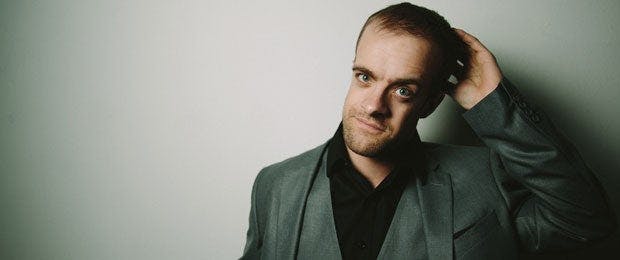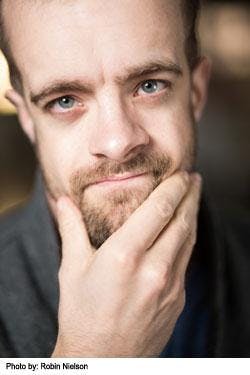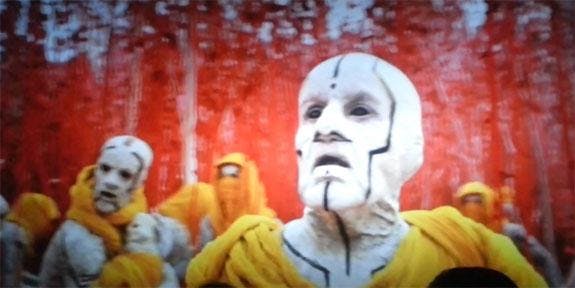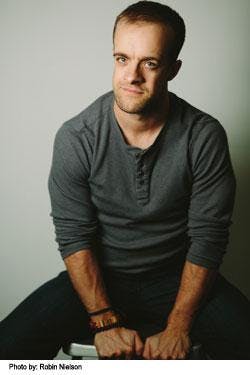Published Jun 30, 2013
Star Trek Into Darkness's Lead Nibiran Shares His Trek Experience
Star Trek Into Darkness's Lead Nibiran Shares His Trek Experience


The opening sequence of Star Trek Into Darkness shines the spotlight on the Nibirans, the primitive humanoids whose sacred scroll Kirk steals in an effort to save them from the imminent eruption of a volcano on Nibiru. Of course, the Nibirans glimpse the Enterprise, setting in motion a Prime Directive debate that will resonate throughout the rest of the movie. The Nibirans make quite the impression on moviegoers, what with their chalky-white skin, pupil-less eyes and lack of ears. Especially striking is the Lead Nibiran, on whom the camera focuses for much of the sequence. He’s played by Canadian actor and musician Jeremy Raymond, who today contributes to StarTrek.com a guest blog in which he details how he landed the unusual role (and the role his unique look played in doing so), reveals what it was like to create the character and shoot his scenes with J.J. Abrams, and shares his thoughts on the potential impact his appearance in Star Trek Into Darkness might have on his life and career moving forward.
There I was, sitting in the Bad Robot offices waiting for my meeting with JJ Abrams. I had been flown down to L.A. earlier that morning and had spent the day meeting with a number of people that were involved in the upcoming Star Trek sequel, but nobody was at liberty to tell me exactly why I was there. I was waiting to hear that from JJ directly.A couple weeks earlier I was in Vancouver, Canada when my agent got a call from JJ Abrams’ office saying that they were interested in me playing a role in the new Star Trek movie. Details about the project were being kept very hush-hush, so I had no idea what part they wanted me to play; however, they asked me to send down a bunch of reference photos for them to draw conceptual sketches on top of. I had gotten the call because JJ had seen a movie I had done and that had triggered some sort of inspiration, but at that point I didn’t even know what movie it was that he had seen.So as I was sitting at Bad Robot; I felt like I was floating in a very cool dream. Then I went into JJ’s office, sat down with him and he filled in all of those blanks for me. He laid out all of the details regarding my section of the story and what my role would be in that segment. He also explained that he had seen a movie that his father, Gerald Abrams, had produced called The Pastor’s Wife (in which I had a small role) at a time when he was trying to figure out a specific problem in Trek 2. He figured I might be part of the solution to that problem. I told him that I would sure like to be. What soon became clear in that meeting is that it was my unique look that had initially grabbed his attention. The simple fact is that I look a little different than a lot of actors, and that has been something of a double-edged sword in my career. For years I would lose out on certain roles just because I stood out too much, or because I did not fit the typical aesthetic of a certain character archetype. It was something I fought against in the early stage of my career, but eventually grew to appreciate. My appearance not only gave me the opportunity to put a unique physical stamp on a role, but my life experiences also gave me a perspective that was different than a lot of my fellow actors. Once I started to take ownership of that, my career path started to unfold in unexpected and exciting ways.It was this distinctiveness that would form the basis for JJ’s solution, but it was clear that there would be a lot of work still to do – more questions that would need to be answered. JJ asked me to join the team and I told him I would be honored.And so it began.After getting the US/Canadian paperwork sorted out, I started flying down to L.A. for makeup tests and pre-production. What was amazing to me was to see how organically the whole process was evolving – the performance would inspire changes in makeup, which would inspire changes in the costume, which would then shape the performance in new ways. Aside from JJ and myself, there were a few people who were absolutely instrumental to the creation of the Nibirans:

Neville Page, the creature designer, seems to have this ability to effortlessly produce wild, amazing conceptual drawings that would make your jaw drop. Michael Kaplan and his wardrobe team created a stunning array of costumes and designs that were wonderful to play around in. And of course the incredible special effects makeup was the result of a lot of hours of hard work by David Anderson and Jamie Kelman. I was first introduced to Star Trek as a kid when my dad and I would sit down and watch The Original Series. We didn’t have cable in our house, so I was only able to catch bits and pieces of The Next Generation and, later, Deep Space Nine. When I got older, one of the two channels we got started showing Voyager, and I was excited to be finally getting in on the ground floor with a series. In each of these series, I always preferred the more unique and strange looking characters, such as Neelix on Voyager and Odo on DS9. Still, I was a pretty casual Trekkie. I have always considered myself a casual fan, but it was in college that I discovered one of my friends was a diehard Star Trek fan, and would come to realize what true fandom was. He had boxes and boxes of Trek literature and would spit fire and brimstone if someone mistakenly referred to him as a Trekkie (“I’m a Trekker, dammit!”).It made me realize that even though I loved watching certain shows or movies (like Lord of the Rings, The Matrix or the original Star Wars trilogy), my devotion was to the telling of stories in film, TV, and theater. Or even around a campfire. And if nobody was around, I would act out these stories. As a kid I would wander around in the woods behind my house in an old bathrobe pretending to be a Jedi, with an old broken fishing rod that served as my lightsaber. I realized later that this was great imagination training for my future career as an actor; particularly for green-screen situations where you have to respond to something that isn’t really there.


